My Friendly Neighbood is the latest entry in the burgeoning niche of Mascot Horror.
At first glance, you might see the bright felt-made characters and bold, colorful text and roll your eyes, which is understandable. But give My Friendly Neighborhood just five minutes of your time and you’ll find a surprisingly holistic, thoughtful, and complete slice of survival horror.
Mascot Horror games tend to invest heavily in the presentation and look of their game. They ensure a striking central character–largely for merchandise sales and click-bait youtube thumbnails. What’s often lacking in these games is a depth of gameplay mechanics, thoughtful level design, and in some cases, a cohesive story.
That’s what made My Friendly Neighborhood such a surprise to me; it has all of those things. The game is a decidedly complete experience. From the art style, graphical fidelity, level design, puzzles and atmosphere, the production value on display is incredible.
The premise is simple. You play as Gordon, a maintenance tech on thin ice with his employers sent to a decommissioned television studio to kill a broadcast of an old puppet program that mysteriously turned back on. We all know what’s about to happen, and it’s just minutes before you’re running from felt puppets out to give you the hug of death. The game wastes no time before releasing you in the studio to solve puzzles, fight enemies, and manage resources.
This was a good approach, as the premise wears its tone and influences on its sleeve. My Friendly Neighborhood embraces the campiness and launches you into it, wasting no time with intrigue or needless exposition. As a tight four/five hour experience this was a good call.
As you delve into the game, you’re quickly introduced to the enemies that gleefully patrol the defunct studio.
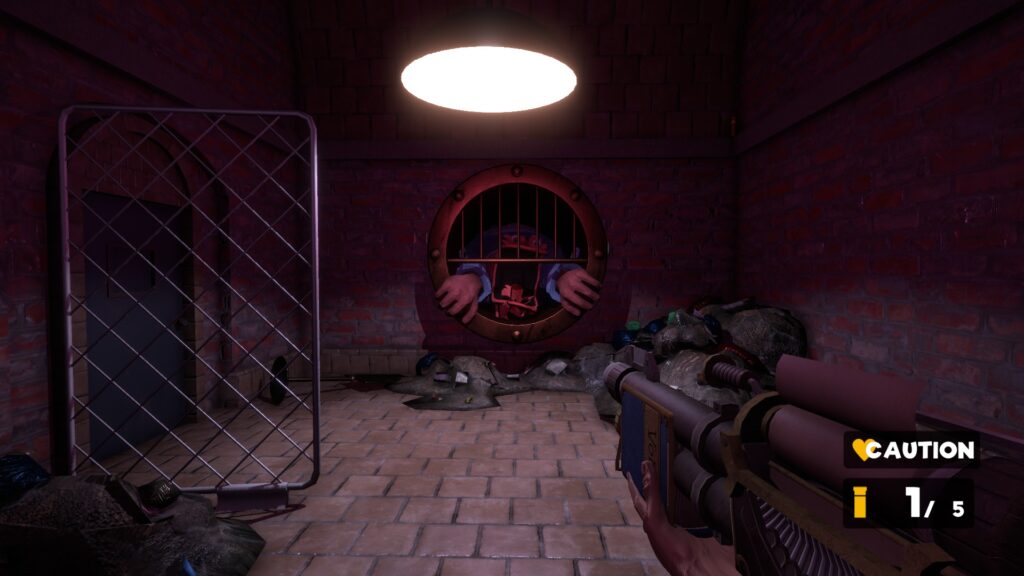
These consist primarily of human-shaped puppets reminiscent of Sesame Street characters. Mechanically, they’re pretty light. They won’t attack on sight–opening up some opportunities to pick your fights and save on resources–but attack by rushing you when you agitate them. Functionally, they work just as zombies do in the Resident Evil series. This certainly won’t be the last time I mention the RE series in this review, as it’s perhaps where My Friendly Neighborhood draws most of its inspiration from. And that’s not a bad thing!
The puppets are great and mindlessly entertaining. Not a moment goes by they don’t endlessly recant the scripts from their children’s show. It’s a constant stream of cheery, pedantic drivel that could be pulled from any children’s program in the real world–if it wasn’t twisted just enough to make the puppets sound maniacal. This is helped by the voice acting, which is perfectly absurd but never grating.
The animation of the main puppets and the few other enemy types in the game is fantastic. They flop around like car-lot-inflatable-tube-men when shot, they explode into ragdoll physics when downed, and there’s a generally high level of graphical fidelity to each one that needs mentioning.
This goes back to the overall production value of My Friendly Neighborhood. It’s felt in each moment of gameplay. Beyond the animation and characters, it’s felt in the environment design too.
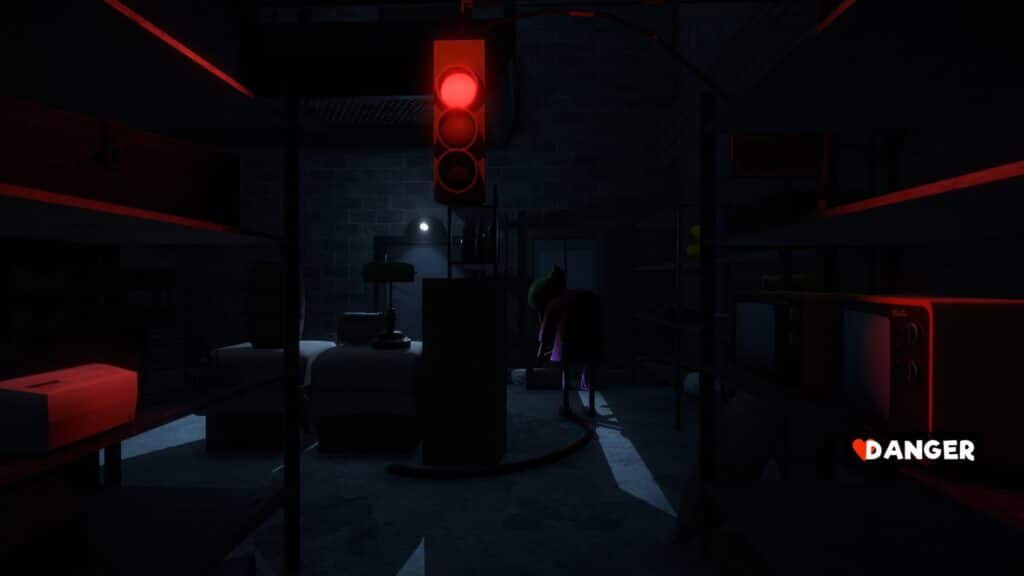
A television studio is a great and largely untapped setting for the horror genre. Games like Five Nights at Freddy’s and Bendy and the Ink Machine have sort of orbited comparable spaces, but in My Friendly Neighborhood, you’re entrenched in it. You spend time running through corporate Art-Deco offices, maintenance tunnels and studio sets. The studio sets are a highlight. Catwalks connect hollowed-out sets, half-built rooms only meant to be seen from one angle, and lighting rigs filled with props. There’s a creepy joy in peeking behind the curtain with these environments, and I wished you spent more time in them before transitioning to the more samey tunnels and offices of the later levels.
There is ample clutter and environmental storytelling going on here. Of course, some of the lore is found in mandatory notes scattered around, but the design of the studio feels authentic and grounded. You’ll find staff areas, prop rooms filled to the brim with décor, work areas for designers, maintenance, and janitorial. The believable layout and design of the studios and offices speak to a level of dedication that the Devs had to My Friendly Neighborhood. I feel immersed in this world less so because of the horror elements, and more so because of the believability of the world they’ve built. Good stuff!
As you explore the studio you’re quickly outfitted with a clever make-shift handgun that fires bold letters out of a Rolladex-style loader.
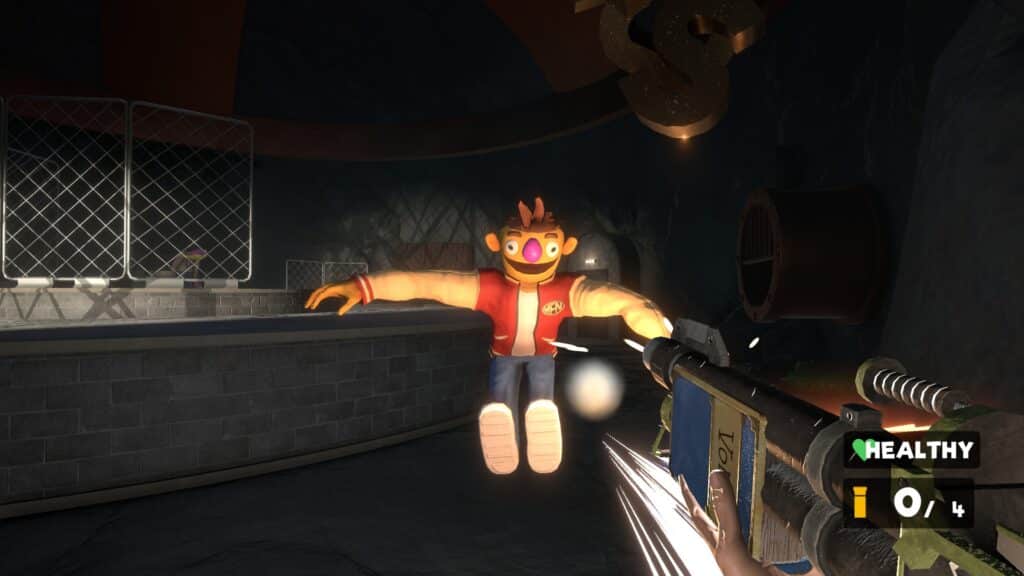
It’s quirky and fun, and the absurdity of it falls right in line with the tone of the game. The feedback when Gordon pulls the trigger is surprisingly powerful, entailing a nice burst of sparks and a notable kick. It’s hilarious to see the puppets fold backward on themselves as a giant letter A ricochets off them. While it might be just as effective as most pea-shooter handguns in comparable horror games, it feels good to shoot, which counts for a lot.
The roster of weapons is slim, which feels fine. You’re given just enough tools to handle a moderately dense amount of enemies that lurk around the studio. Much like the classic Resident Evil games, juggling ammo and inventory space is a central mechanic in My Friendly Neighborhood. As you load up on health, key items and ammo you must make frequent trips to many save rooms scattered around the studio. Managing these items is classic in the best way.
I only ran into the issue of inventory space once I got within the last hour or two of the game. Early game key items and weapons’ are light, trips back to the save room are frequent. Later, you’re loaded up with weapons and grenades which take up most of your space, with some larger key items choking up even more space. admittedly, I wish that inventory management was more prominent in the early game as well. The earlier stages feel a little more rail-roaded because of this. Making considerations about which resources you need to keep or leave, learning routes around the studio and remembering which enemies are where are all staples of the games My Friendly Neighborhood are emulating, and it would have been great to do more of that.
When it does kick in though, it really shines. Once you’re through the early studio and sewer levels, My Friendly Neighborhood opens up in a really cool way. You head to the upper studios which feels very reminiscent of a certain mansion located in the Arklay Mountains. You’re inundated with keys and key items that require constant map checking, lining up gem-shaped keys to their appropriate locked doors. You’ll unlock switch-back shortcuts to other floors, elevators that cut past enemies, and key items to use in previously explored areas of the studio.
It’s a surprisingly pleasant escalation in the late game that we rarely see in Survival Horror games. It was a joy to be stocked on key items and ammo and be sent back to previous areas to clear out those pesky locked rooms or unresolved puzzles. An example is when you’re still in the early game there is a chess-piece electrical puzzle(sound familiar?) that has the potential to unlock two doors. At first shake, you can only unlock one of them. It was a nagging problem in the back of my mind, thinking perhaps I missed something. It wasn’t until hours later that I received the missing piece to unlock the other door. Not only that, but the game opened up an alternative means to get back down there which cut the travel time and loading screens down significantly. Really, really good stuff.
Perhaps a drawback to this aspect of My Friendly Neighborhood is that not much new happens when you have to revisit these previous areas. In classic Resident Evil you might see a Hunter appear, or MR. X might now roam those areas, whereas here you’re lucky to find a new puppet lingering around. A little variation in the environment upon your return would have been welcome.
There’s a surprising amount of optional events to witness. As you progress you’ll find items to unlock optional rooms and set pieces.
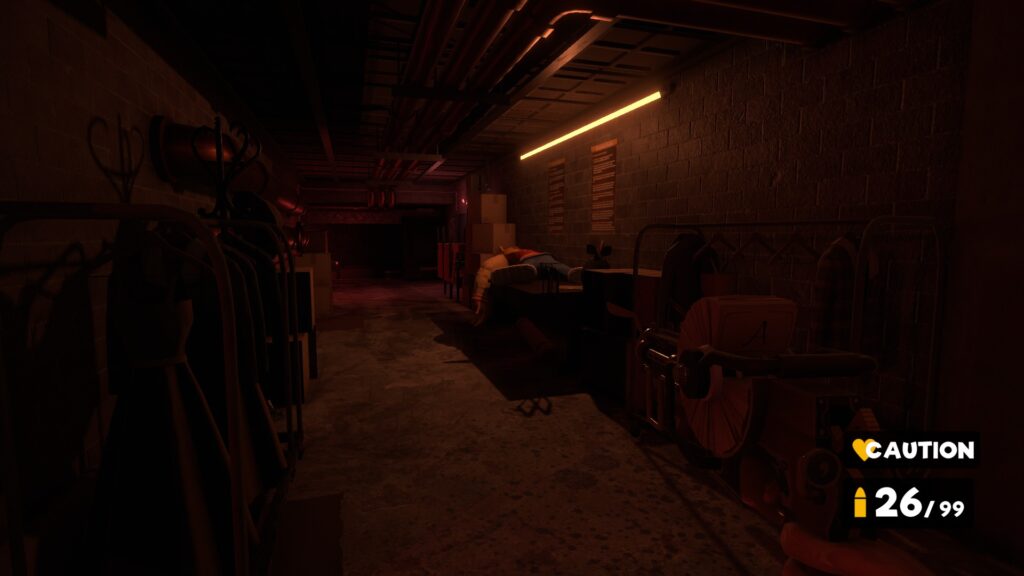
Upon first playthrough I saw a touching moment in a movie theater after collecting some film reels, and a scene in the sewers involving some wonderful animation and voice acting. It goes back to the production value within My Friendly Neighborhood. The Devs really explored the scope of this project to its fullest, adding these optional moments that go such a long way in making the game and story feel complete.
Most of these optional character moments speak to the themes of the game and Gordon’s struggle. Below the endless cheeriness and camp are tons of guilt, malaise induced by work and media, and the hardening of one’s heart after trauma. It never takes center stage and I think the game is better for it, but there is some nice introspection to be found through notes and sparse interactions Gordon has with other characters.
To further the feeling of completeness here, the puzzles are great. They strike that perfect balance of challenging on initial glance, then “clicking” quickly. There are of course the obligatory fuse and key puzzles, but there are some thematically fitting ones as well.
One sees you playing a risky board game with Norman, one of the resident puppets. Breaking the rules by drawing a card at the wrong time or landing on the wrong spot and you’ll receive a firm smack to the face. Another sees you managing personnel time cards, and another has you rearranging pieces on a playground based on where characters are positioned around it. None of these puzzles are serious headscratchers, but they feel just right for the genre. With the culmination of some fun puzzles, My Friendly Neighborhood has shown it knows all of the mechanics of the survival horror genre.
Perhaps the only thing the game lacks is scares. Most of the environments are very well-lit, there isn’t much tension between encounters, and the overall tone is so light that it doesn’t leave much room for horror.
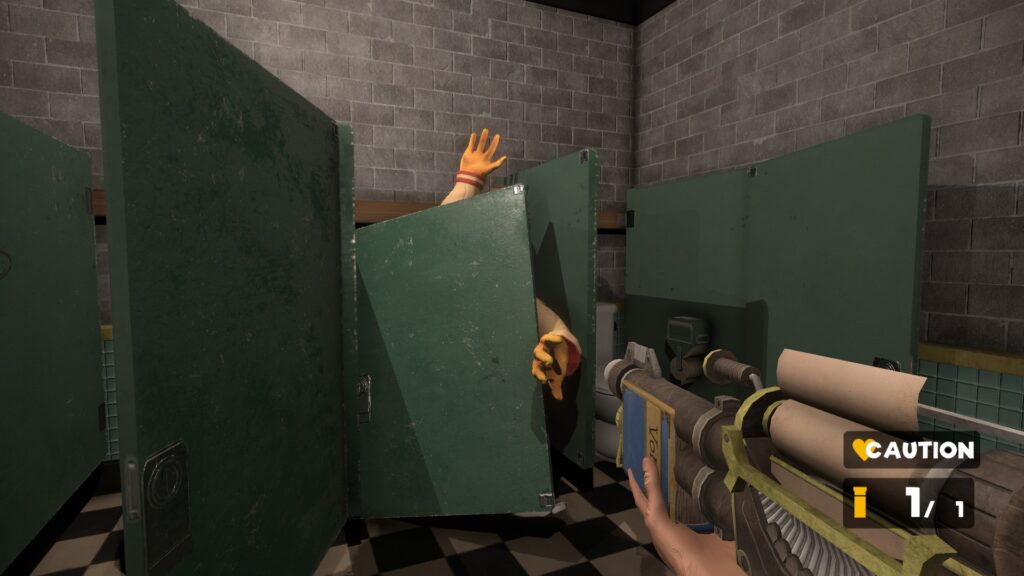
Normally, this would be a heavy mark against a game like this. But My Friendly Neighborhood knows exactly what it’s doing and focuses more on the systems within the old-school survival horror genre, rather than simply going for scares. The emphasis is always on the gameplay and the pacing of the game.
You’ll notice this quickly, and I think the game is better for it. The only tension to be found in the gameplay comes from inventory management. Resources become thin as you progress and the puppets sometimes take many shots to down, creating some tight situations as you outmaneuver them or re-route to avoid fighting.
It amounts to fun, goofy ride that should feel right at home to any survival horror fan. The deep respect shown to the originators of the genre can be felt in the thoughtful and complex level design, tricky inventory management and save rooms, and persistent enemies that require careful dispatch. But it’s not just the homage to the classics that make My Friendly Neighborhood great, it’s more than that. It’s how complete the experience feels. If you’re a fan of survival horror, do not miss this one.
You can buy My Friendly Neighborhood here on Steam
